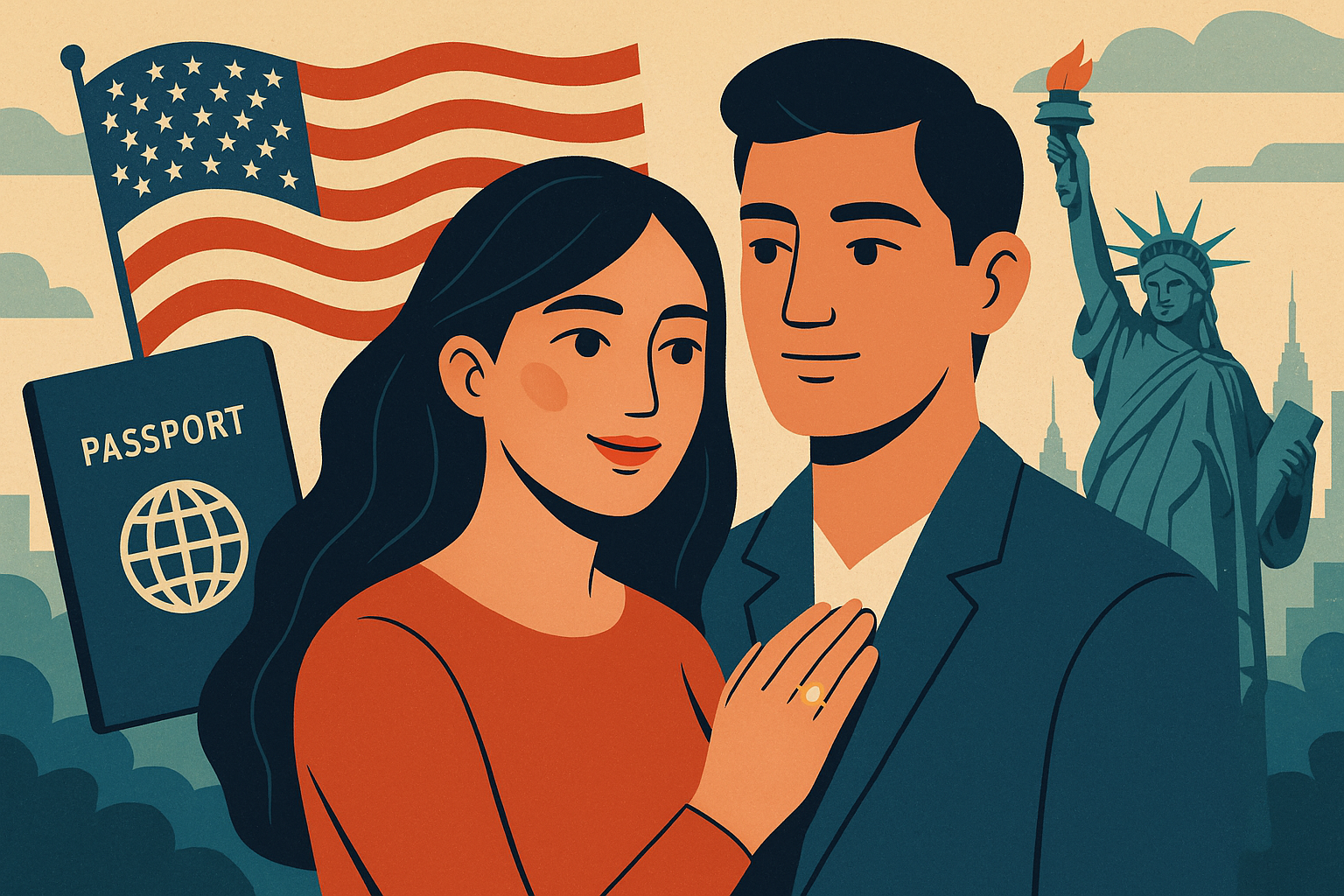Fiancé Visa Guide
Date of Information: 07/10/2025
Check back soon; we update these materials frequently

What is a Fiancé Visa (K-1)?
The K-1 fiancé visa allows a U.S. citizen to bring their foreign-citizen fiancé(e) to the United States for the purpose of marriage. The visa requires the couple to marry within 90 days of the fiancé(e)'s entry into the U.S. After the marriage, the foreign spouse becomes eligible to apply for adjustment of status to become a lawful permanent resident (green card holder).
This is a non-immigrant visa with the expectation of adjustment to immigrant status following marriage.
Legal Eligibility Requirements
To qualify for a K-1 visa, the couple must meet the following requirements:
Petitioner must be a U.S. citizen (not a lawful permanent resident).
Both parties must be legally free to marry (i.e., all prior marriages terminated).
The couple must have met in person within the past two years (exceptions exist for extreme hardship or cultural practices).
The couple must intend in good faith to marry within 90 days of entry into the U.S.
The petitioner must be able to financially support the beneficiary (generally 125% of the Federal Poverty Guidelines).
Process Stages and Timeline
Below is a breakdown of the major forms involved, along with key milestones:
Step 1: Submit Petition for Alien Fiancé(e)
Complete Form I-129F:
Filed by the U.S. citizen with USCIS.
Establishes the relationship and intent to marry.
Requires proof of meeting in person and documentation of the relationship.
Documents required at this stage include:
Proof of U.S. citizenship (e.g., passport, birth certificate)
Proof of relationship (photos, chats, travel itineraries)
Written statements of intent to marry
Evidence of in-person meeting (boarding passes, hotel receipts)
Divorce decrees or death certificates for prior spouses
Processing time: ~6–10 months
Step 2: Transfer to the National Visa Center (NVC)
After USCIS approves the I-129F petition, it sends the case to the National Visa Center (NVC). The NVC’s role in K-1 cases is purely administrative. It:
Assigns a case number,
Routes the approved petition to the U.S. Embassy or Consulate designated for the foreign fiancé(e), and
Notifies the petitioner of the embassy assignment.
Important: The NVC does not process or adjudicate Form DS-160. That responsibility belongs entirely to the embassy.
Step 3: Embassy Processing
Once the U.S. Embassy receives the petition, it takes over direct communication with the foreign fiancé(e) and issues instructions to:
Submit Form DS-160 (Online Nonimmigrant Visa Application)
Schedule a medical examination with an approved panel physician
Collect and prepare civil documents
Schedule and attend the K-1 visa interview
DS-160:
This form is completed online at https://ceac.state.gov and collects biographic, travel, and background information. It must be submitted prior to the visa interview and is processed by the embassy, not the NVC.
Visa Interview:
During the interview, a consular officer will verify the relationship, evaluate admissibility (including criminal and immigration history), and review all documents. If the visa is approved, it is usually issued within days to a few weeks.
Step 4: Entry into the United States and Marriage
The K-1 visa is valid for a single entry within six months. Upon entry into the United States, the couple must marry within 90 days. If they fail to do so, the foreign national must leave the U.S., or risk being out of status.
No extensions are available. The 90-day rule is firm.
Step 5: Adjustment of Status
After the couple is married in the U.S., the foreign spouse may apply to become a permanent resident (green card holder) by submitting Form I-485. From this point on, the process is very similar to that used for marriage visas. We encourage you to review our research guide on the marriage visa process for more information.
Supporting documents include:
Proof of lawful K-1 entry
Certified marriage certificate
Financial sponsorship documents (Form I-864)
Immigration medical exam (if not already submitted via embassy)
Optional: Forms I-765 (work permit) and I-131 (travel permit)
Interview:
Most adjustment cases involve a USCIS interview to confirm the legitimacy of the marriage.
Processing Time: ~12–20 months, depending on jurisdiction
Client Document Checklist
To initiate the K-1 process, clients should provide their attorney with the following:
From the U.S. Citizen Petitioner:
Copy of U.S. passport or birth certificate
Certificate of naturalization (if applicable)
Divorce decree(s) or death certificate(s) from any prior marriages
Signed letter of intent to marry
Evidence of in-person meeting (photos, travel docs, etc.)
Evidence of ongoing relationship (chat records, call logs, emails)
IRS tax returns or tax transcripts (last 3 years preferred)
Recent pay stubs (last 6 months)
Employment verification letter
Completed Form I-134 (Affidavit of Support)
From the Foreign Fiancé(e):
Copy of valid passport
Birth certificate (with certified English translation)
Police clearance(s) from countries of past residence (6+ months)
Divorce or death certificates (if previously married)
Two U.S.-style passport photographs
Signed letter of intent to marry
Completed Form DS-160 confirmation page
Medical exam results from embassy-approved physician
Embassy-specific forms (as directed)
Optional but Recommended:
Wedding planning evidence (receipts, reservations, announcements)
Sworn affidavits from friends/family confirming relationship
Joint travel records, financial planning, or future housing documents
Frequently Asked Questions (FAQs)
Q: Can we get married outside the U.S. and still use the K-1 process?
A: No. The K-1 visa is only for couples who will marry in the U.S. within 90 days of arrival. If you marry abroad, you’ll need to file an immigrant visa petition (I-130) for a CR-1 or IR-1 spousal visa instead.
Q: Are same-sex couples eligible?
A: Yes. U.S. immigration law recognizes same-sex relationships and applies all immigration benefits equally.
Q: Can my fiancé(e)’s children come too?
A: Yes, eligible children under 21 may apply for K-2 visas to accompany the K-1 beneficiary.
Q: What if we don’t marry within 90 days?
A: The foreign national will fall out of status and be subject to removal. They cannot adjust status based on a different petitioner. Marriage outside the 90-day window still disqualifies them from adjusting based on the original K-1.
Need Help with a Fiancé Visa?
Navigating the K-1 process is not just about submitting paperwork — it’s about understanding how to avoid pitfalls, delays, and denials. At Charles International Law, we bring decades of experience in both international law and U.S. immigration to help you succeed.
We offer:
Strategic guidance on eligibility and timing
Detailed document checklists and templates
High-quality petition preparation and review
Ongoing representation through USCIS and embassy processing
Adjustment of status services after your fiancé(e) arrives
Other Helpful Resources:
See Also:
CIL Guide to Family-Based Immigration
CIL Guide to Marriage Visas
CIL Guide to Financial Sponsorship in Family-Based Immigration
CIL Guide to Green Cards and Adjustment of Status

